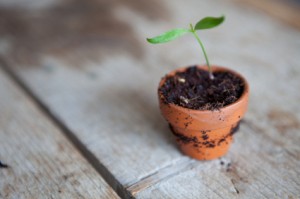 I have had good success in growing many things from cuttings, like hibiscus and frangipani (plumeria), by dipping the stem in honey and putting the cutting into sandy potting mix mixed 50/50. If the weather is cold to cool, a plastic bag over the pot gives a hothouse style of growing.
I have had good success in growing many things from cuttings, like hibiscus and frangipani (plumeria), by dipping the stem in honey and putting the cutting into sandy potting mix mixed 50/50. If the weather is cold to cool, a plastic bag over the pot gives a hothouse style of growing.
Hydrangeas grow easily from cuttings too. Make sure there is a least 3 eyes (leaf nodes). The bottom one should be placed in the soil (I use potting mix) and this is where the roots will grow from, Also cutting off any large leaves is important so all of the plants energy can go to making roots.
Source: This was information from my mother who was an avid gardener
By joycerose from Morley, WA
This page contains the following solutions.
Many plants, including those considered annuals in your area, can be over-wintered indoors and used as starts in your spring garden, whether it be in the ground or in containers, or both.
It's easy to grow shrubs and many other plants by simply planting a branch. Cut off a branch and bury it in decent soil leaving only 6-8 inches out of the ground.
Starting roots on fresh flowers so they can be planted and come back every year. The gift that keeps on giving.
There are many plants that let you take cutting to start new plants. Why not start some in "give-a-way pots". I have several transplants waiting for the right person.
If you're wanting to landscape your property, but not wanting to spend a lot of money doing so, alert your family, friends, fellow church members, co-workers, etc.
I've posted so many pictures of plants I've rooted, I don't think one will be necessary here. I haven't tried this tip as I have no trouble rooting cuttings.
The kids old sandbox makes a great place to grow cuttings for starting new plants! Be sure to shade the new cuttings from the sun and water frequently until you see new growth. These little plants you are growing will sell for $5.00 each at your next garage sale!
I save all sorts of small glass, and plastic, bottles, fill them with water and use them for rooting cuttings. It is a very productive and interesting pastime, looking to see how the roots develop over time.
I have used several methods for starting plants for my own use. I once moved on to property that had no trees. Early the next spring, with the blessing of a neighbor, I clipped very thin branches that where long and straight and more then 3 ft long and had buds barely cracked.
Pull the branches down away from the bush so they will lay on the ground. Do not cut but scrape away the bark where it touches the ground.
An easy way to root angel trumpets, confederate rose, and rose of Sharon is to cut a branch off and put it in water halfway up the stem until it has roots.
Here are the questions asked by community members. Read on to see the answers provided by the ThriftyFun community.
I would like advice for starting new plants from clippings of the plants I have.
Hardiness Zone: 9a
By Kevin
I use rooting hormone if I remember. I have 2 old aquariums in
which I put about 1/2 " of vermiculite. I use potting soil or perlite in pots or six packs, I have very good luck with this method. I put glass on top of the aquariums, leaving it open at one corner for ventilation.
I am moving in November from Rhode Island to Cape Cod, Massachusetts and need to bring a small root of my dad's lilac tree, my mom's peonies bulbs, and small roots of forsythias. Can someone tell me how to preserve these over the winter to be able to plant them at my new home in the spring please?
Store them in damp peat moss in a very cool place and they should be fine.They are all quite tough. Remember to make sure you have at least 5 eyes on your peony or it will take a long time to bloom.
How do I root plants (whips)?
By Eddie
You didn't specify what type of plants but it sounds like you are trying to root some sort of tree whips. If that is the case just cut
off the whips you want, remove lower leaves and cut bottoms at a slant. You can use a medium like rootone or if you have access to a willow tree just cut off several branches {fresh and small} and pour boiling water over them and allow to cool. Just put the fresh cut whips in a container and add the willow water and wait for them to root. Check the ends occasionally to make sure they are not getting slimy and change the willow water at least once a week (rooting hormones are made of willow bark!). Good luck.
Can I use rooting hormone on perennial plants?
Hardiness Zone: 4a
By kelly from Lacrosse, WI

Yes, you can. For more info search for your question. Lot of info there, good luck.
How important is the type of plant cutting? If you for example, take a hardwood cutting when it should be a semi-ripe cutting, would the plant still grow?
If you dip the ends in rooting powder and harden them off before you put them in the ground they should all be fine.
To truthfully answer your question; Yes - No - Maybe
I'm one of those gardeners that do not like to discard cuttings of any kind so I keep good planting medium waiting in pots, 'just in case' I do some unexpected pruning.
I keep my rooting powder container in my pocket at all times.
I keep a large container of water ready so I can place cuttings in water until I have time to finish preparing for potting soil.
My potting soil has only a small amount of 'soil' and mostly Perlite and peat moss.
I have grown beautiful plants from all sorts of cuttings without ever checking to see what type of cutting grows best from that plant.
I do not advocate doing this but it's just easier for me and if I only get 2 good plants from 8 cuttings that suits me.
I do place my cuttings in separate containers so I know which is which when the plants start growing.
There are lots of plants that can be started/grown in water but I like using my potting soil.
Here are a couple of links that I keep handy just in case I'm looking for particular information about cuttings.
content.ces.ncsu.edu/
www.ugaoo.com/
I had some photos to show but cannot get the image loader to work.
There is the following rules:
softwood cuttings are taken from soft, young plant stems, usually in spring to early summer;
semi-hardwood cuttings are taken from stems that are not too young and also not too old, and usually in late summer to fall;
hardwood cuttings are taken from mature, dormant stems of trees, shrubs and climbers that do not bend easily, in mid-autumn all through winter (avoiding times of severe frost) or early spring while the plant is still dormant.
It is best to follow these rules if you want to successfully propagate plants.
Hardwood cuttings are a simple way to multiply plants.
Suitable plants for hardwood cuttings include most deciduous shrubs (abelia, buddleja, cornus, forsythia, ribes, rosa, viburnum and more), climbers (lonicera, jasminum), fruit (currants, fig, gooseberries) and some trees
www.hillier.co.uk/
I think these links will be useful to you:
www.purdue.edu/
www.ugaoo.com/
deepgreenpermaculture.com/
deepgreenpermaculture.com/
If you take a hardwood cutting when it should be a semi-ripe cutting, then the probability of successful propagation of the plant is low.
Also, I would advise you to first check whether a particular plant can be propagated using a cutting.
Plants that grow from stem cuttings:
gardeningtips.in/
Not every plant is good for the hardwood-cutting method of propagation.
What steps should I take for preparing my cuttings before dipping them into rooting compound?
By Glenn
Check out these photos.
My friend asked me for clippings from my garden and this is what she is getting. These succulents sit in a wooden box and floral foam oasis. The handle is foxtail fern and the succulents include aeoniums, kiwi, burro's tail, campfire, and many filler plants from my garden. I say spring is here!
This is a page about making a plastic bottle propagator. A plastic drink bottle can easily be converted into a mini greenhouse for small plants and cuttings. Save your next empty drink bottle and give it a try.
This is a page about rooting plants in water. Rooting your new plant cutting in water is a very effective method. Depending on your choice of container it can also be interesting to watch the roots develop.
Rooting cuttings is often done by creating a mini greenhouse using plastic bottles or wrap. This method will work, but too much humidity can be harmful to the cuttings, thus requiring wiping to remove excess moisture. An alternative is to create a micro climate for your cuttings. This method is explained in depth on this page.
Sharing plant cuttings with friends and family is easy. Follow the instructions on this page describing how to ship plant cuttings using a wet paper towel, plastic wrap, and a rubber band.
Using floral foam you can create an environment to root a variety of plants from cuttings. Here you can learn to easily root flower and tree cuttings.